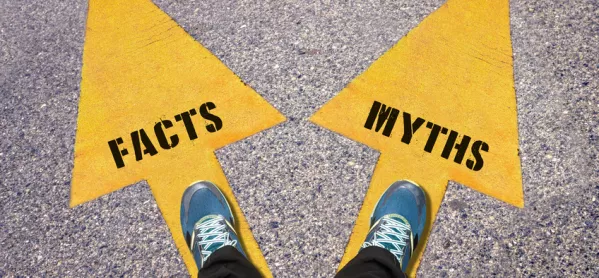Sound evidence-based practice requires teachers to discriminate, evaluate and apply a variety of sources of information. Do you?
Oliver Caviglioli, a former special school headteacher and pioneer of innovative teaching concepts, recently teamed up with the Learning Scientists, a group of US academics who promote the use of evidence-based teaching strategies. They collaborated on Twitter to determine a continuum of sources of information that teachers can use to find out about how students learn, from the subjective to the objective.
Below, I explore the benefits and limitations of each of these sources.
Intuition and experience
Highly subjective, intuition often derives from a desire to find patterns and connections in randomness. Sometimes people overestimate their intuition and prevent themselves from making sound decisions. Take the roulette player who observes five reds come in one after another, and believes that there is little chance that a red can come in again, so places his bet on black. But, of course, the odds are still the same regardless of how many reds came before.
Liken this to the classroom. We use our intuition and experiences to guide us in the situations that we face day to day. Being short of time means that teachers don’t have the opportunity to contemplate decisions; rather, they act in the moment when it comes to judgements on how students learn best.
American psychologists Veronika Denes-Raj and Seymour Epstein propose that people process information in two modes - one identified by terms such as “rational”, “analytical” and “deliberative”, and the other by terms such as “experiential”, “automatic”, “intuitive” and “natural”.
The latter is a dangerous concoction of highly subjective approaches. Conversely, experience can support us contextually, particularly when fewer objective sources are available to us. Moreover, intuition can be useful in opening yourself to new ideas that rational thinking may not allow.
CPD sessions
Although some CPD sessions are informative, and outside experts can act as agents for change, there are a lot of snake-oil salespeople out there. These individuals work in their own best interests to promote ideas and resources, failing to provide unbiased information that is backed by research into how students learn.
Furthermore, there remains limited evidence to support the impact of one-off CPD sessions on teaching and learning. However, a CPD session is likely to have the most value if it is well-informed and part of an ongoing community of practice.
Communicating with peers
Teacher learning communities are held in high regard by Dylan Wiliam, emeritus professor of educational assessment at University College London, who advocates the idea over the traditional “sheep-dip” approach to CPD.
Can teacher learning communities alone really tell us how students learn? Probably not. Yet in terms of trialling strategies that are informed by more objective sources, it is certainly worth working with peers to determine how students learn best in your context.
Articles and blogs
This very article includes some bias towards particular sources. And the nature of this publication provides all in education a voice - some more authoritative than others. Blogs can be produced by anyone and perhaps reinforce bad practice. Having said that, information in the media and blogs is current and highly accessible, so why not use it as a starting point to find out how students learn?
Dan Williams is an FE practitioner in the Midlands @FurtherEdagogy
This is an edited version of an article in the 24 June edition of TES. Subscribers can read the full version here.
FE SPECIAL OFFER: click here to try out a TES Further Education subscription for just £1 for four weeks.
Want to keep up with the latest education news and opinion? Follow TES FE News on Twitter, like us on Facebook and follow us on LinkedIn



